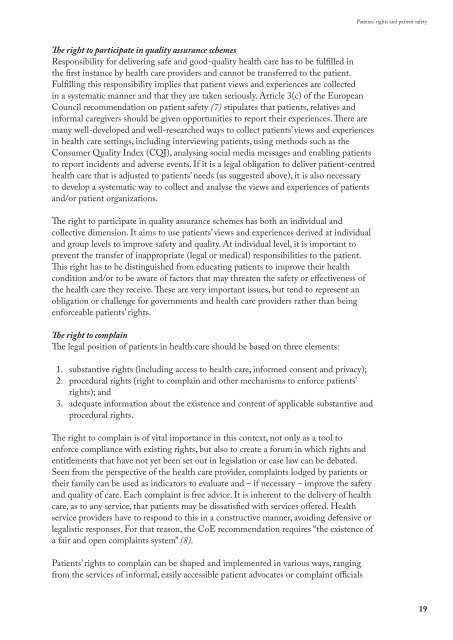Exploring patient participation in reducing health-care-related safety risks
Exploring patient participation in reducing health-care-related safety risks
Exploring patient participation in reducing health-care-related safety risks
Create successful ePaper yourself
Turn your PDF publications into a flip-book with our unique Google optimized e-Paper software.
The right to participate <strong>in</strong> quality assurance schemes<br />
Responsibility for deliver<strong>in</strong>g safe and good-quality <strong>health</strong> <strong>care</strong> has to be fulfilled <strong>in</strong><br />
the first <strong>in</strong>stance by <strong>health</strong> <strong>care</strong> providers and cannot be transferred to the <strong>patient</strong>.<br />
Fulfill<strong>in</strong>g this responsibility implies that <strong>patient</strong> views and experiences are collected<br />
<strong>in</strong> a systematic manner and that they are taken seriously. Article 3(c) of the European<br />
Council recommendation on <strong>patient</strong> <strong>safety</strong> (7) stipulates that <strong>patient</strong>s, relatives and<br />
<strong>in</strong>formal <strong>care</strong>givers should be given opportunities to report their experiences. There are<br />
many well-developed and well-researched ways to collect <strong>patient</strong>s’ views and experiences<br />
<strong>in</strong> <strong>health</strong> <strong>care</strong> sett<strong>in</strong>gs, <strong>in</strong>clud<strong>in</strong>g <strong>in</strong>terview<strong>in</strong>g <strong>patient</strong>s, us<strong>in</strong>g methods such as the<br />
Consumer Quality Index (CQI), analys<strong>in</strong>g social media messages and enabl<strong>in</strong>g <strong>patient</strong>s<br />
to report <strong>in</strong>cidents and adverse events. If it is a legal obligation to deliver <strong>patient</strong>-centred<br />
<strong>health</strong> <strong>care</strong> that is adjusted to <strong>patient</strong>s’ needs (as suggested above), it is also necessary<br />
to develop a systematic way to collect and analyse the views and experiences of <strong>patient</strong>s<br />
and/or <strong>patient</strong> organizations.<br />
The right to participate <strong>in</strong> quality assurance schemes has both an <strong>in</strong>dividual and<br />
collective dimension. It aims to use <strong>patient</strong>s’ views and experiences derived at <strong>in</strong>dividual<br />
and group levels to improve <strong>safety</strong> and quality. At <strong>in</strong>dividual level, it is important to<br />
prevent the transfer of <strong>in</strong>appropriate (legal or medical) responsibilities to the <strong>patient</strong>.<br />
This right has to be dist<strong>in</strong>guished from educat<strong>in</strong>g <strong>patient</strong>s to improve their <strong>health</strong><br />
condition and/or to be aware of factors that may threaten the <strong>safety</strong> or effectiveness of<br />
the <strong>health</strong> <strong>care</strong> they receive. These are very important issues, but tend to represent an<br />
obligation or challenge for governments and <strong>health</strong> <strong>care</strong> providers rather than be<strong>in</strong>g<br />
enforceable <strong>patient</strong>s’ rights.<br />
The right to compla<strong>in</strong><br />
The legal position of <strong>patient</strong>s <strong>in</strong> <strong>health</strong> <strong>care</strong> should be based on three elements:<br />
1. substantive rights (<strong>in</strong>clud<strong>in</strong>g access to <strong>health</strong> <strong>care</strong>, <strong>in</strong>formed consent and privacy);<br />
2. procedural rights (right to compla<strong>in</strong> and other mechanisms to enforce <strong>patient</strong>s’<br />
rights); and<br />
3. adequate <strong>in</strong>formation about the existence and content of applicable substantive and<br />
procedural rights.<br />
The right to compla<strong>in</strong> is of vital importance <strong>in</strong> this context, not only as a tool to<br />
enforce compliance with exist<strong>in</strong>g rights, but also to create a forum <strong>in</strong> which rights and<br />
entitlements that have not yet been set out <strong>in</strong> legislation or case law can be debated.<br />
Seen from the perspective of the <strong>health</strong> <strong>care</strong> provider, compla<strong>in</strong>ts lodged by <strong>patient</strong>s or<br />
their family can be used as <strong>in</strong>dicators to evaluate and – if necessary – improve the <strong>safety</strong><br />
and quality of <strong>care</strong>. Each compla<strong>in</strong>t is free advice. It is <strong>in</strong>herent to the delivery of <strong>health</strong><br />
<strong>care</strong>, as to any service, that <strong>patient</strong>s may be dissatisfied with services offered. Health<br />
service providers have to respond to this <strong>in</strong> a constructive manner, avoid<strong>in</strong>g defensive or<br />
legalistic responses. For that reason, the CoE recommendation requires “the existence of<br />
a fair and open compla<strong>in</strong>ts system” (8).<br />
Patients’ rights to compla<strong>in</strong> can be shaped and implemented <strong>in</strong> various ways, rang<strong>in</strong>g<br />
from the services of <strong>in</strong>formal, easily accessible <strong>patient</strong> advocates or compla<strong>in</strong>t officials<br />
Patients’ rights and <strong>patient</strong> <strong>safety</strong><br />
19



